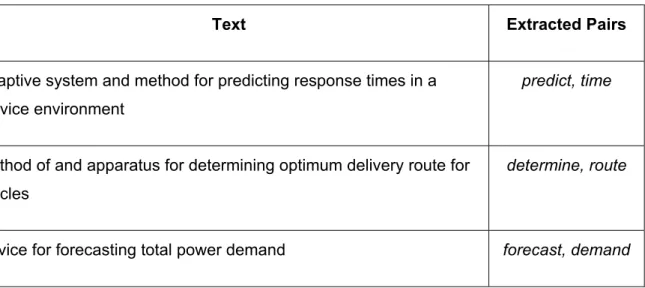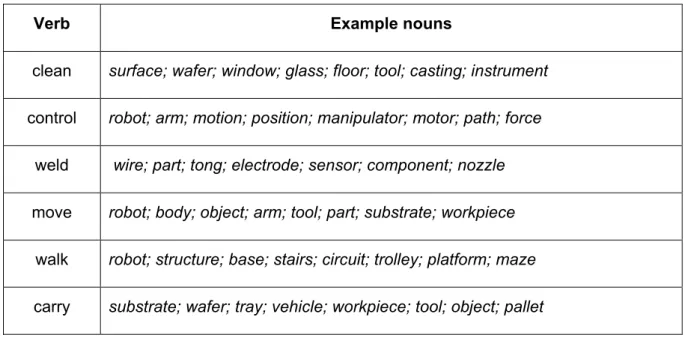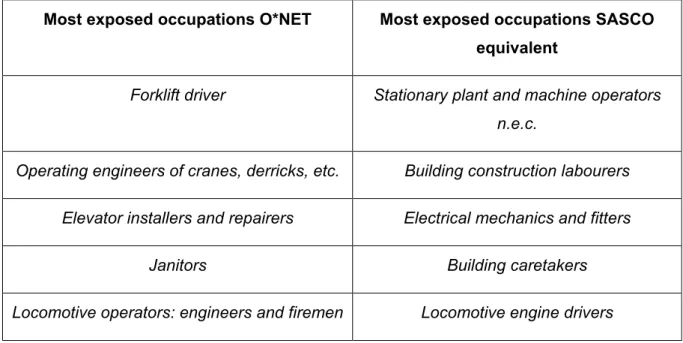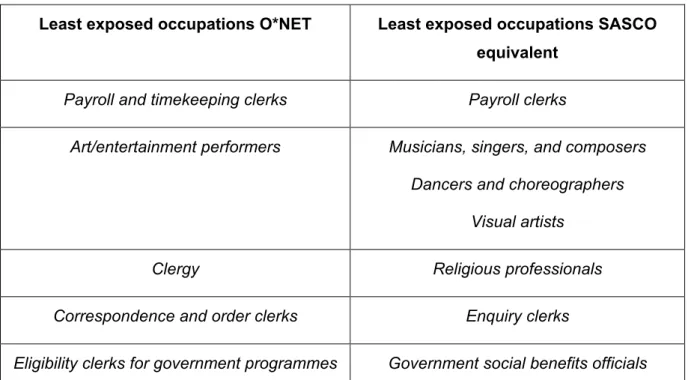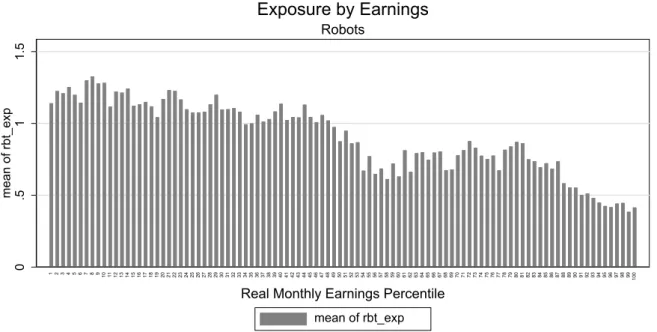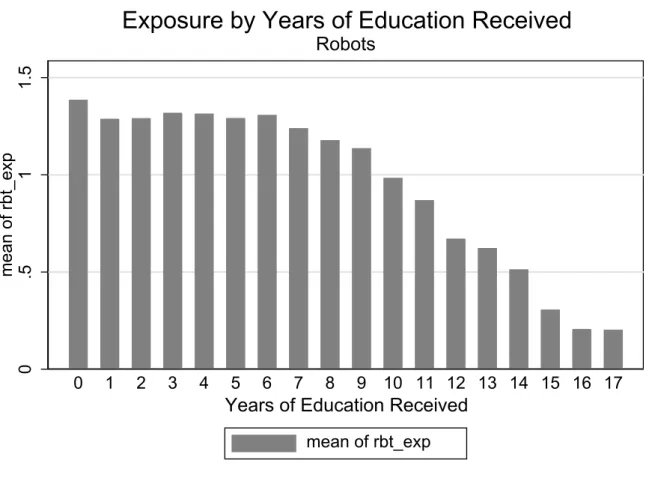61 Figure 4-4: Average occupational-level exposure scores for robotics outcomes by gender and population group. 69 Figure 4-8: Average occupational-level exposure scores for software technology outcomes by gender and population group.
INTRODUCTION
- Introduction
- Technologies of the Fourth Industrial Revolution
- The South African Labour Market
- Problem Statement
- Objectives
- Research Method
- Webb’s Data
- PALMS Data
- Chapter Outline
The extent to which the South African labor market has been affected by automation technologies remains unclear. The empirical analysis follows a quantitative research approach with the aim of measuring the extent to which different professions in the South African labor market are exposed to the effects of automation technologies.

LITERATURE REVIEW
Introduction
The third section explores the (negative) economic consequences of technological change by discussing how labor displacing capital affects inequality. The fourth part discusses the economic consequences of the adoption of automation technologies, in particular the impact of technological change on inequality and polarization of the labor market.
The South African Economy and Labour Market
- The South African Economy Post-1994
- The South African Labour Market
Labor market participation in South Africa is strongly influenced by education and is obviously skills-oriented. The polarization of the labor market in South Africa is discussed in detail in section 2.5.
The Disruptive Nature of Technological Change
- Labour, Output and Technological Change
- The History of Industrial Revolutions
- The Fourth Industrial Revolution (Industry 4.0)
The 1960s brought the Third Industrial Revolution, which overlapped with the beginning of the Fourth Industrial Revolution. 4IR is expected to disrupt the work environment at an unprecedented pace and scale, enabled by digital technologies that are enabled by general-purpose technologies that were developed in previous industrial revolutions, eg, the microchip.
Technologies of the Fourth Industrial Revolution
- Robots
- Digital Software
- Artificial Intelligence
A change to the robot's function would therefore require a physical change to the machine's design. This is particularly relevant when productivity growth is dependent on the invention (and application) of entirely new technologies, such as in the case of AI.
Technological Diffusion
In this introductory period, the transformative influence of new technologies remains limited to directly related industries and those developing the associated infrastructure (Fernández-Macías, 2018). As the necessary infrastructure is developed, new technologies mature, allowing the requisite skills and knowledge needed to make effective use of a new technology to be disseminated and put into practice across a range of industries and sectors (Fernández-Macías, 2018: 2).
The Displacing and Reinstating Effects of Automation Technologies
- New Occupations
- The Displacement Effect
Much of the employment growth in the US is accounted for by new occupations that fulfill new functions in society. First, the productivity effect describes how the cost savings generated by automation increase consumer demand, increasing the demand for labor for tasks that are not automated. Second, the capital accumulation effect describes how automation increases the capital intensity of production, triggering the accumulation of capital, which also increases labor demand in tasks where automation technologies complement human labor (Lane. & Saint-Martin, 2021: 30). .
Although the above effects are significant, they are unlikely to fully counteract the crowding out effects of automation technologies in the near term. It describes a process by which the demand for human labor to perform certain tasks and occupations is reduced (or in some cases eliminated) as a result of technological advances. Due to the displacement effect, which at the same time increases production, labor's share of national income will also be reduced, which effectively decouples wages from productivity gains (Lane & Saint-Martin, 2021:30).
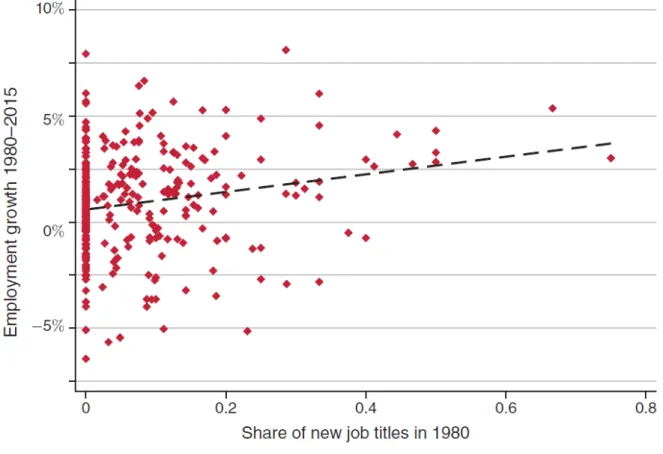
The Economic Consequences of Adopting Automation Technologies
- Inequality and the Return on Capital
- Labour Market Polarisation
- Drivers of Labour Market Polarisation
Secondly, existing economic inequalities are exacerbated by such a bias as it can lead to a hollowing out of the middle class and thus polarize the labor market in the process (Le Roux, 2015:1). During this process, the structure of the labor market distribution is changed to form peaks on both sides. Studies by Levy and Murnane and Wolfson noted a decline in the size of middle-class and middle-income populations during the labor market polarization process.
Autor and Dorn (2013) conducted an empirical study of the polarization of the US labor market between 1980 and 2005 by analyzing wages and growth of low-skilled service occupations during this period. Acemoglu and Autor (2011) noted that growth in demand for both high-skilled, high-paid occupations and low-skilled, lower-paid occupations is an important feature of labor market polarization. This process culminates in the documented polarization of labor market structures in most industrialized economies (OECD, 2017).
Labour Market Polarisation in South Africa
Furthermore, much of the wage growth for lower-income laborers is driven by minimum wage legislation rather than routine biased technical change, particularly female domestic workers and male farm workers (Bhorat et al., 2020a:27). Although routine-biased technical change may be less useful in explaining the contraction of the primary and secondary sectors in South Africa, it remains important to consider the significant extent of the tertiary sector (represented by non-routine labor) as growth in employment. the entire skill distribution in the service sector has shown different growth rates for various reasons (Bhorat et al., 2020a:27). During the 2000 to 2015 period, GDP contributions from the business and financial services sector rose by around 4.8% per year, making them the fastest growing sectors in the economy, second only to construction (Bhorat et al., 2020a :27). 2020a:27) points out that although highly skilled professional technical service occupations have shown employment growth, lower service occupations have shown similar employment growth patterns.
However, occupations in the lower end of the service sector are not necessarily as well paid. This is consistent with the findings of the research conducted by Choudhury et al. 2019), who suggest that this is because workers working in environments that require a high degree of familiarity with software, such as the Information Technology (IT) sector, are also more familiar and aware of new technologies of AI due to similarities in the form and function of the software used. This ultimately leads to increased productivity and wages (Felten et al, which is particularly relevant in the context of an already polarized and segmented labor market in South Africa. 2019:27) study how labor market polarization is influenced by new technologies introduced such as AI by developing a measure they call Artificial Intelligence Impact on Work (AIOI).
Conclusion
However, the existing literature suggests that the impact of AI on the labor market, rather than acting as a tool for large-scale automation, may be similar to that of previous ICTs, as the technology tends to complement skills related to the use of software (Felten et al. al. The results of this paper raise concerns about the impact these technologies may have on income inequality and labor market polarization. However, it is too early to assess the impact of technologies that to fully assess long-term economic growth and productivity from the 4IR and labor market structures of developing economies.
This chapter discussed South Africa as a case study for automation and examined how its economy and labor market structures have developed since 1994. It further discussed past and current global trends in automation and the effects it has on labor markets in the form of general inequality and labor market polarization. The following chapter will provide an overview of the method developed by Michael Webb (2019) to determine occupational exposure measures to different technologies (industrial robots, software applications and AI), together with how this study compares the values he calculated in the context of the South African labor market.
METHODOLOGICAL APPROACH
- Introduction
- Description of Data and Datasets Used
- Michael Webb Database
- PALMS Database
- Michael Webb’s Method
- Extracting Verb-Noun Pairs from Patent Titles
- Extracting Verb-Noun Pairs from Occupation Task Descriptions
- Calculating Occupation Exposure Scores
- Measuring Overlap Between Extracted Verb-Noun Pairs
- Transforming Webb’s Data to a South African Context
- Transforming Listed O*NET Occupations to Listed SASCO Occupations
- Difficulties Faced While Converting Listed O*NET Occupations to Listed
- Conclusion
As discussed in the next section, Webb calculated the degree of overlap between the text of occupational task descriptions and the text of registered patent titles. To gather information about occupations and the various tasks they comprise Webb (2019) used the O*NET database. The second step was to rank each of the O*NET documented occupations together with their corresponding SASCO equivalent counterparts.
This process is shown in the third column of Table 3, which shows the first 43 entries of the database compiled for this study. There were problems finding exact SASCO profession counterparts for each of the documented O*NET professions. To get around this limitation, each of the O*NET professional titles had to be individually linked to an equivalent SASCO counterpart.
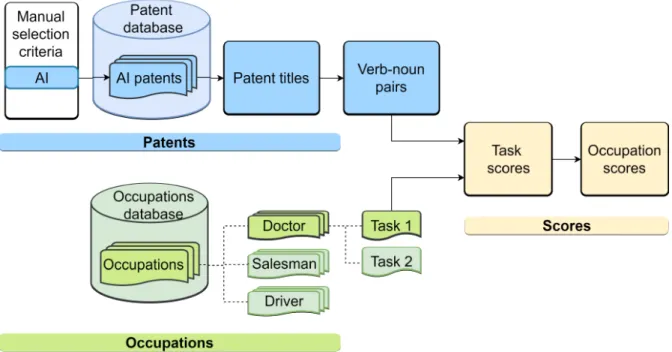
EMPIRICAL ANALYSIS
Introduction
Descriptive Evidence: Robots
- Some of Webb’s Data
- Exposure by Earnings Percentile
- Exposure by Level of Education
- Exposure by Age
- Exposure by Gender and Population Group
Descriptive Evidence: Software
- Some of Webb’s Data
- Exposure by Earnings Percentile
- Exposure by Level of Education
- Exposure by Age
- Exposure by Gender and Population Group
Descriptive Evidence: Artificial Intelligence
- Some of Webb’s Data
- Exposure by Earnings Percentile
- Exposure by Level of Education
- Exposure by Age
- Exposure by Gender and Population Group
Change in Earnings and Employment
- Change in Earnings Regression
- Change in Employment Share
Conclusion
CONCLUSION
Introduction
Employers and governments around the world face great difficulty in responding to structural changes in the labor market due to the uncertainty caused by the lack of empirical evidence about the effects that modern technologies have on employment and the working environment. Much of the absence of evidence can be attributed to the unprecedented speed and scale of modern technological change (Spencer et al., 2021:50). The answers to such questions are becoming increasingly ambiguous in the context of developing economies.
As such, the aim of this study was to determine the extent to which the South African labor market experiences exposure to automation technologies. To do this, this study measured the South African labor market's exposure to these technologies across various demographics, i.e. a laborer's earnings percentile, years of education a laborer received, a laborer's age , and their gender and population group. The topic is topical due to the advent of 4IR and is particularly relevant in the context of the developing South African economy, which suffers from high levels of inequality, poverty and unemployment.
Summary
Concluding Remarks
This study found that the expected potential exposure to technologies that include AI is different from the potential exposure scores of the previous two case studies, namely that those workers who perform more abstract tasks are now also more likely to experience higher levels of exposure. These workers generally received more education and earned a higher monthly salary than workers in the other two case studies.
Policy and Future Research Recommendations
Reworking the Revolution, https://www.accenture.com/_acnmedia/PDF- 69/Accenture-Reworking-the-Revolution-Jan-2018-POV.pdf. Robotics and the future of production and work. https://itif.org/publications robotics-and-future-production-and-work. Notes from the AI Frontier: Modeling the Impact of AI on the World Economy. https://www.mckinsey.com/featured-. knowledge/artificial-intelligence/notes-from-boundary-modeling-its-impact-on-the-world-economy.
McKinsey Global Institute, discussion paper). https://www.mckinsey.com/featured-insights/artificial-intelligence/notes-from-the-ai-frontier-modeling-the-impact-of-ai-on-the-world-economy. Cape Town: DataFirst [] manufacturer and distributor]. https://www.datafirst.uct.ac.za/dataportal/index.php/catalog/434/download/10286. The Collected Writings of John Maynard Keynes, Vol. https://www.nytimes.com opinion/krugman-sympathy-for-the-luddites.html.
